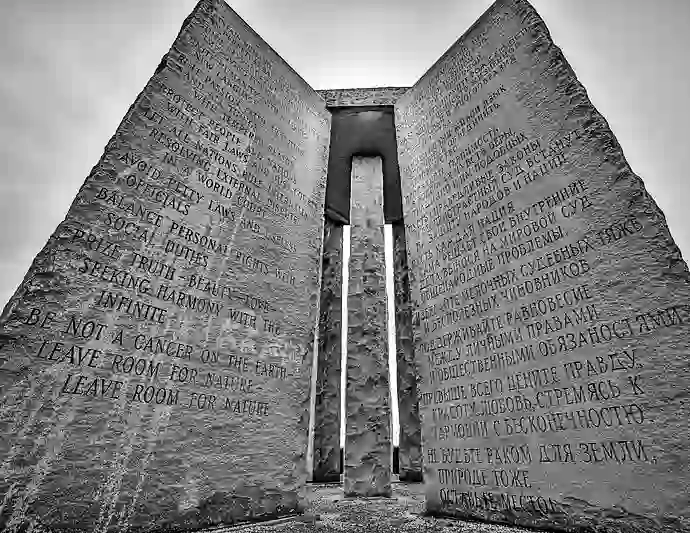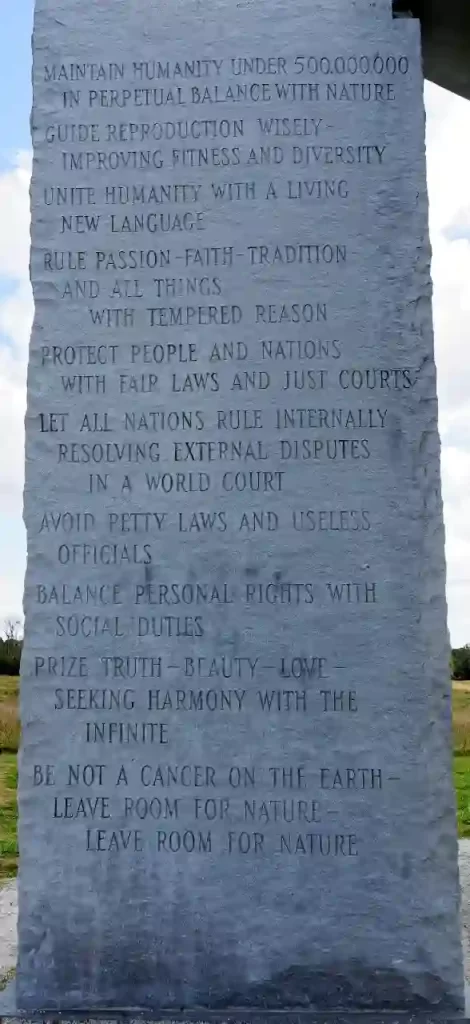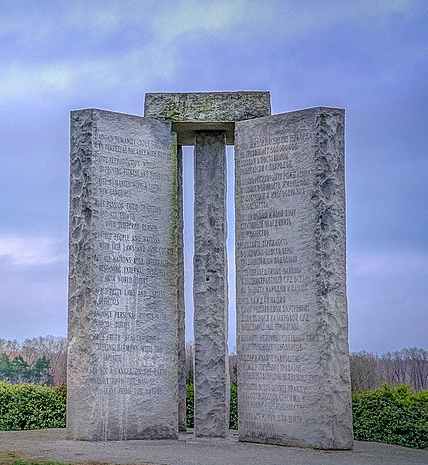Unraveling the Mystery of the Georgia Guidestones
A massive riddle looms on the outskirts of Elberton, Georgia, and has puzzled visitors and locals alike since its strange debut in 1980; The Georgia Guidestones Let’s pull back the curtain on the mystifying structure.
The monument has been subjected to graffiti and defacement throughout the years, owing primarily to conspiracy theories and disputes regarding the phrases carved on the stones. Despite these incidents, the Georgia Guidestones remained and attracted tourists from all over the world who were drawn to its mystery and the knowledge or prophecies; they may contain.
The Georgia Guidestones were severely damaged by a bombing incident on a summer morning in 2022. Because of the monument’s significant damage, it was demolished on the same day. Later that month, Elberton Mayor Daniel Graves proposed plans to rebuild the landmark monument.

On August 8, however, the Elbert County Board of Commissioners opted against rebuilding. Instead, they decided to gift the damaged monument to the Elberton Granite Association. They also chose to return the approximately 5 acres of property where the monument had stood to its original owner.
Georgia Guidestones | The American Stonehenge
The Georgia Guidestones, often known as “The American Stonehenge,” is a collection of five granite slabs with a central pillar about 20 feet tall, erected in a distinctive star design atop a plot of land in rural Georgia. The monument is made of robust and weather-resistant granite and is meant to stand the test of time as a sentinel against the elements.
The structure of the monument is an engineering wonder. The four outer stones span around 18 feet and are aligned with the cardinal points of the compass. A central stone lies in the heart of the structure, with four enormous stone slabs radiating outward. A capstone sits atop the five underlying stones, crowning the construction.
However, the most noticeable feature of the Guidestones is the collection of inscriptions that adorn its facade. Each of the four outside stones has a set of ten rules or principles etched in eight different languages: English, Swahili, Spanish, Hindi, Hebrew, Arabic, Chinese, and Russian. These tenets include directives like “Keep humanity under 500,000,000 in perpetual balance with nature,” “Guide reproduction wisely — improving fitness and diversity,” and “Unite humanity with a living new language.”
The capstone also has inscriptions in four ancient languages: Babylonian (in cuneiform script), Classical Greek, Sanskrit, and Egyptian hieroglyphs. In these languages, the Guidestones are stated to be guided to an “Age of Reason.”
A hole in the center stone corresponds with the North Star, while a slot aligns with the Sun’s solstices and equinoxes, accentuating the monument’s astronomical elements. Every day at noon, the Sunbeams through a narrow hole in the stone, illuminating the date on an engraving.
These engravings, however, are buried in mystery. Others see them as scary instructions for recreating civilization after an apocalyptic event, while some understand them as advice for a wealthy, sustainable life. The origins of the monument add to the mystery. An unidentified individual commissioned the work recognized only as “R.C. Christian,” whose identity remains unknown.

Who Owned the Land
The site on which the Georgia Guidestones were built was formerly held by Wayne Mullinex, a local cattle farmer. Mullinex and his family were reportedly given lifetime cattle grazing rights on the plot of land in exchange for its use.
R.C. Christian, the individual who commissioned the monument, had bought this tiny plot of land in Elbert County, Georgia, intending to create the Georgia Guidestones. The property and monument were returned to Elbert County once the monument was completed in 1980.
The Construction Process of Georgia Guidestones
The Elberton Granite Finishing Company did the actual construction work. “R. C. Christian” spoke to the company’s president, Joe Fendley, requesting to create a monument to him. Fendley was key in overseeing the production and erection of the monument, working with a group of unidentified backers. The granite used in the construction came from Elberton, recognized as the “Granite Capital of the World.”
Multiple stages and meticulous attention to detail were required during the construction process. The first step was to quarry the granite locally at Elberton due to its abundant stone resources. Granite is a solid and durable rock, making it an excellent material for a long-lasting monument.
The granite was then cut and shaped to the exact specifications supplied by “R.C. Christian.” The granite monument is made up of four big upright stones, a center stone, and a capstone. Each of these stones was fashioned and polished to the exact specifications required.
The next step involved the inscriptions. The monument was created to communicate ten suggestions or ideas in eight current languages: English, Spanish, Swahili, Hindi, Hebrew, Arabic, Chinese, and Russian. These inscriptions were carefully carved into the granite slabs. Furthermore, the capstone included inscriptions in the scripts of four ancient languages: Babylonian Cuneiform, Classical Greek, Sanskrit, and Egyptian Hieroglyphs.
The final stage was the monument’s assembly and erection. The five main stones were arranged in a paddle-wheel design, with the center stone in the middle and the four other stones surrounding it. The capstone was then placed on top. The capstone was subsequently attached at the top. According to the design guidelines, each of the stones was precisely aligned with various astronomical features,
Joe Fendley and the Elberton Granite Finishing Company oversaw the project’s complex fabrication and assembly methods in partnership with unknown backers. Despite the complexity of the project and the mystery surrounding its commission, they completed the monument per “R.C. Christian’s” idea. The finished monument is a testament to the expertise and workmanship of those who worked on it.

The Ten Commandments of Georgia Guidestones
Ten inscriptions are carved into the monument’s surface in eight different languages: English, Swahili, Spanish, Hindi, Hebrew, Arabic, Chinese, and Russian. This diversity of languages shows that the monument’s message is intended to be accessible to a vast portion of humanity.
The messages themselves, while brief, have significant implications and have been dubbed “Ten Commandments for the Age of Reason.” Here’s a brief look at the inscriptions and the thought-provoking wisdom they propose
1. Maintain humanity under 500,000,000 in perpetual balance with nature: This first message is highly contentious, as it suggests a significant decrease in the Earth’s population, fueling speculation about a future worldwide catastrophe.
2. Guide reproduction wisely: improving fitness and diversity: This sentence could be taken as a call for genetic engineering or careful family planning.
3. Unite humanity with a living new language: The third principle offers a shared language to promote better understanding and togetherness among people.
4. Rule passion — faith — tradition — and all things with tempered reason: This guiding principle appears to value reason over emotion, faith, and practice.
5. Protect people and nations by enacting fair laws and establishing just courts: This rule supports justice and fairness on both an individual and national level.
6. Let all nations rule internally, resolving external disputes in a world court: This inscription encourages global collaboration in resolving international conflicts.
7. Avoid petty laws and useless officials: This could be viewed as a plea for more efficient and streamlined governance.
8. Balance personal rights and social duties: This principle promotes a harmonic balance of individual freedoms and societal responsibilities.
9. Prize truth — beauty — love — seeking harmony with the infinite: This principle apparently encourages the pursuit of truth, beauty, and love.
10. Be not cancer on Earth — Leave room for nature — Leave room for nature: This final lesson emphasizes environmental stewardship, emphasizing the importance of respecting and conserving nature.
These inscriptions, nicknamed the “Ten Commandments of the Antichrist” by some, are somewhat cryptic recommendations for humanity’s survival and harmony. While some applaud them as a feat of foresight, others regard them with skepticism, viewing them as frightening instructions for a post-apocalyptic future.
The wisdom carved on the Georgia Guidestones is meant to guide humanity toward rational thought and living in harmony with nature. The inscriptions, however, have been interpreted in various ways, sparking discussion and adding to the monument’s mystique.

Who is R.C. Christian? The Mystery Man Behind the Georgia Guidestones
The monument’s sponsor is only known by the nickname “R.C. Christian,” which has sparked much discussion and mystery.
R.C. 1979 Christian approached the Elberton Granite Finishing Company with the monument’s blueprints. He claimed to represent a small group of loyal Americans who had been planning this monument for 20 years. The choice of the pseudonym was deliberate; he confessed that it was not his real name but refused to reveal his true identity.
His demeanor, behavior, and knowledge, particularly concerning stone masonry, suggested that he was well-educated and may have had a military history. These hints, however, have yet to result in a conclusive identification. The people who directly interacted with him respected his wish for anonymity and maintained his secret.
Several theories concerning R.C. Christian’s identity have emerged throughout the years. Christian, Some conspiracy theorists have proposed links to notable historical personalities, secret societies, or groups advocating a new global order.
Using a name so near to that of “Christian Rosenkreuz,” the alleged founder of the Rosicrucian Order, an old philosophical order, has generated speculation about a Rosicrucian connection. Some speculate that Ted Turner, the media billionaire, and well-known environmentalist, is the man behind the stones because of his ties to Georgia and the environmental themes on the stones.
Regardless of these opinions, no substantial proof has emerged to back up any claim about R.C. Christian’s true identity. This lack of knowledge has contributed to the Georgia Guidestones’ feeling of mystery, further enticing visitors who visit and study this unique monument. As of now, the identity of R.C. Christian remains one of the monument’s unsolved mysteries.
Georgia Guidestones Explosion
An explosive device targeted the Georgia Guidestones in the early hours of a Wednesday morning. This explosion caused severe damage to the structure, causing authorities to demolish it for safety reasons.
A massive chunk of the granite slab broke apart and crashed due to the explosion. Shortly after the explosion, a car was seen leaving the scene. The incident occurred in a residential location and resulted in no injuries.
Elbert County’s governing authority owns the monument, and destroying a public building with an explosive carries a minimum term of 20 years in prison without the chance of parole.
District Attorney Parks White emphasized that the crime endangered many people and that demolishing a public, historic property is a criminal offense, regardless matter how individuals feel about the monument.
Significant debate has been about reconstructing the Georgia Guidestones since the explosion and subsequent destruction. If such a decision is made, several granite manufacturers have expressed interest in giving resources and materials.
The Granite Association, which comprises members who were engaged in building the Guidestones, is set to meet soon to debate the issue. There has also been some public support for the reconstruction effort, with a Tennessee resident expressing a wish to contribute monetarily to the project despite having never visited the site.
However, the Elbert County Board of Commissioners has stated that the county would not reconstruct the monument. The Guidestones were initially given to the county.
A clause in the deed states that if the monuments were ever moved, the land would revert to the original owner. The Board of Commissioners considers that this should be fine if a group chooses to reconstruct the monument.

Nevertheless, the Board of Commissioners in Elbert County chose not to undertake reconstruction. They made a resolution to give the broken monument to the Elberton Granite group. In addition, they decided to hand back the close to 5-acre land, which previously housed the monument, to the proprietor who owned it initially.
What Happened to Georgia Guidestones Time Capsule
The Georgia Guidestones featured a slab with an incomplete inscription that suggested a time capsule. “placed six feet below this spot on… to be opened on…” stated the inscription. Because the sentence was unfinished, determining when the alleged time capsule was buried and when it was scheduled to be opened was challenging. This curiosity developed, particularly after the monument was destroyed.
A search party was formed to locate the time capsule in response to the rumors and the directions on the slab. Officials from the Elbert County Road Department and an excavator were brought in to dig six feet underground. However, when they reached the six-foot mark, they discovered more dirt and no time capsule.
To add to the mystery, Elberton Granite Association Executive Vice President Chris Kubas indicated that a granite sign at the site implied the time capsule was buried there. He stated that the time capsule was deposited in that position in 1982, two years after the Guidestones were constructed. However, no time capsule was discovered after the group excavated six feet deep until they reached compacted red clay.
Contrary to social media speculation, no time capsule containing items from the late 1970s and early 1980s was located. Claims of discovering artifacts such as a signed magazine issue featuring Burt Reynolds, an 8-track of the “Saturday Night Fever” soundtrack, a Peterbilt emblem, and several dozen Quaaludes were debunked as pranks.

A Beacon for Believers and Skeptics
The Georgia Guidestones have captivated many spectators, from enthusiastic believers to staunch skeptics, making them a true beacon for many groups of people. The messages they carry, the languages chosen, the astrological alignment, and the mystery of their origin have sparked much discussion and speculation.
For believers who believe in the stones’ ability to offer wisdom or prophecy, the monument is a priceless item. The instructions of the stones are viewed as a blueprint for humanity’s future, passing wisdom on restoring civilization in an apocalyptic situation. Many of these believers believe that the monument is part of a broader story or design, with interpretations ranging greatly depending on various belief systems.
Some environmentalists, for example, see the stones’ emphasis on the natural balance and population management as a confirmation of the need for sustainable living. Similarly, globalization supporters may consider the need for a new common language and a world court as a step toward a more unified global community.
On the other hand, skepticism has a quite different take on the Georgia Guidestones. Some see them as elaborate hoaxes or publicity stunts. Some doubters challenge the rules’ viability and ethics, highlighting worries about issues such as population control and a single world language, which might be interpreted as pushing for authoritarian control.
The Guidestones have additionally aroused the interest of conspiracy theorists, with allegations ranging from the involvement of secret societies such as the Rosicrucians or the Illuminati to assertions of New World Order schemes. The pseudonym of the monument’s sponsor, R.C. Christian, has fueled these theories due to its closeness to “Christian Rosenkreuz,” the alleged founder of the Rosicrucian Order.
The Mystery Associated with the Guidestone
Origin and Purpose: The Guidestones’ origin and purpose remain a mystery. The individual or organization who commissioned the project is only known by the pseudonym “R.C. Christian.” The identity of this person or group and their exact aim in erecting the monument remains unknown.
Astronomical Alignment: The Guidestones have certain astronomical features. A hole drilled in the center stone corresponds to the North Star, while a slot carved in the center corresponds to the solstices and equinoxes. These coincidences have sparked speculation regarding their significance. Could they be part of an old calendar system, a way to measure time, or simply a symbolic gesture to the universe?
The Ten Guidelines: The most intriguing riddle is the ten inscriptions, or recommendations, written in eight languages. The concepts range from keeping the population under 500 million to properly managing reproduction, resulting in various interpretations. Some regard them as a roadmap to a new age of reason, while others see them as post-apocalyptic commands.
Languages and Scripts: The languages employed on the Guidestones—eight modern and four ancient languages—are a mystery in and of themselves. Why were these specific languages chosen? And why are the inscriptions on the capstones in ancient languages? These options have resulted in various theories, including connections to ancient civilizations or specific cultures.
Numerical Mysteries: The proportions of the Guidestones are thought to have been selected using sacred geometry concepts. A physical time capsule is also buried beneath the monument, with the date to be opened left blank. These elements raise concerns regarding the monument’s numerical and geometric value.
The pseudonym “R.C. Christian”: This has been interpreted as a reference to Christian Rosenkreuz, the reputed founder of the esoteric Rosicrucian Order. Is this a hint as to who the sponsor is, or a red herring intended to mislead?

The Guidestones’ Grip on Popular Culture
Notwithstanding the controversy, the Georgia Guidestones has carved itself a place in popular culture. They’ve been featured in several documentaries, films, books, and even music and sparked debates on everything from sustainable living to dystopian futures.
The Georgia Guidestones have captivated people and broader public culture due to their mystique and contentious inscriptions. They’ve been mentioned and covered in different forms of media, arousing curiosity and igniting debate.
The Guidestones play an important part in the science fiction novel “The Seventh Angel” by Jeff Edwards. The idea of the book is a global catastrophic event, with the Guidestones functioning as a survival blueprint.
The mystery of the Guidestones has also been explored on television. “Brad Meltzer’s Decoded” on the History Channel devoted a program to the monument, researching its origins and potential significance. The Travel Channel documentary series “America Unearthed” also investigated the Guidestones, adding to their mystique.
In terms of music, the American death metal band Nile mentions the Georgia Guidestones in their song “In the Name of Amun,” with the lyrics implying a possible apocalyptic scenario, which corresponds to some readings of the stones’ inscriptions.
The Guidestones have also had an impact on the world of comic books. The Georgia Guidestones play an important role in the comic book “The X-Files: Season 10,” as agents Mulder and Scully examine the monument’s prophetic warnings.
Furthermore, the monument’s impact can be seen in digital media and gaming. It is a location in the 2015 visual novel video game “Shin Megami Tensei: Devil Survivor 2 – Record Breaker” where the player can face opponents.
Conclusion
The recent bombing and subsequent demolition of the Georgia Guidestones have stirred debate over the monument’s future. Several stakeholders, including granite manufacturers and a national association, have expressed interest in reconstructing the monument, and public support for such an attempt has been indicated.

However, the Elbert County Board of Commissioners has stated that the county will not be responsible for the reconstruction. The land on which the monument stood is subject to a deed provision that states that if the monuments were ever moved, the land would revert to the original owner. However, this is not considered to be an issue if a group decides to reconstruct the monument.
The bombing incident, which resulted in the monument’s destruction, has drawn attention to the Guidestones’ historical and cultural value and the legal ramifications of harming such a landmark.
Despite their recent devastation, the Georgia Guidestones continues to attract interest and spark debate. As talks regarding the monument’s future progress, the Guidestones serve as a reminder of the delicate balance between preserving historical sites and respecting the laws that protect them. Their story also highlights the persistent appeal of mystery and the human desire to find meaning in the unknown.







